Establishing Shot 1: Format and Practice
Annette Danto
Summary

Credit: Maria Uspenskaya
Think/Point/Shoot explores media ethics in contexts ranging from preproduction to production, postproduction and distribution. It also highlights ethical issues raised by new media such as alternative modes of production and content creation, interactivity, and real-time distribution.
Diverse media operate at different speeds and for different durations. The time factor introduces unique ethical challenges. For example, a feature filmmaker may work on a screenplay for years. This allows time to ponder story elements. Blogging, and especially live-tweeting, on the other hand, requires instantaneous decision-making with little or no time to consider ethical pitfalls.
Take Home Points
- Understand the importance of compassion and empathy for others. Avoid seeing people as tools for self-promotion and self-gain.
- Acknowledge being a global citizen; a member of a heterogeneous world with awareness of differences as well as shared human needs.
- Practice self-reflection and critical thinking about your own traditions and behavior.
References
Alia, V. (2004). Media ethics and social change. New York, NY: Routledge.
Online
Anderson, J. W. (2006, January 31). Cartoons of prophet met with outrage. Washington Post Foreign Service. Retrieved from www.washingtonpost.com/wp-dyn/content/article/2006/01/30/AR2006013001316.html
Common Sense Media. (2011, October 25). Common sense media research documents media use among infants, toddlers, and young children. Retrieved fromwww.commonsensemedia.org/about-us/news/press-releases/common-sense-media-research-documents-media-use-among-infants-toddlers
Common Sense Media.(2015, November 3). Landmark report: U.S. teens use an average of nine hours of media per day, tweens use six hours. Retrieved fromwww.commonsensemedia.org/about-us/news/press-releases/landmark-report-us-teens-use-an-average-of-nine-hours-of-media-per-day.
Gutnick, A. (2011, March 10). Always connected: The new digital media habits of young children. The Joan Ganz Cooney Center. Retrieved from www.joanganzcooneycenter.org/publication/always-connected-the-new-digital-media-habits-of-young-children/
Hebrew University of Jerusalem. (2010, September 19). Prof. Martha Nussbaum on “humanistic education & global justice.” Retrieved from https://youtube.com/watch?v=A_IR1CID3Ns
Helber, S., Ramsey,P., & Drew, J., The Associated Press. (2015, August 8). Reporter, cameraman killed on air; gunman dies. The Daily Local. Retrieved from www.dailylocal.com/article/DL/20150826/NEWS/150829836
Kessler, S. (2011, March 15). Study: 80 percent of children under 5 use internet weekly. USA Today. Retrieved from http://content.usatoday.com/communities/technologylive/post/2011/03/study-80-percent-of-children-under-5-use-internet-weekly/1#.VonwR7NunIU
Oppenheimer, J. (2012). Statements. Retrieved from The Act of killing (film): http://theactofkilling.com/statements/
Ovalle, D. (2013, December 4). South Miami Facebook killer pleads not guilty to first-degree murder. Miami Herald. Retrieved from www.miamiherald.com/news/local/community/miami-dade/article1958188.html
Raskin, M. (2013, January 3). Managing your children’s screen time. The Washington Post. Retrieved from www.washingtonpost.com/lifestyle/style/managing-your-childrens-screen-time/2013/01/03/9c47cea2-2e84-11e2-89d4-040c9330702a_story.html
Shedden, D. (2002, July 20). Media ethics bibliography. Retrieved fromwww.poynter.org/uncategorized/785/media-ethics-bibliography/
Wire Reports. (2015, August 26). Killer played to Twitter age in on-air shootings in Virginia. The Dallas Morning News. Retrieved from www.dallasnews.com/news/headlines/20150826-killer-played-to-twitter-age-in-on-air-shootings-in-virginia.ece
Case Study
Case StudyDiscussion Questions
- Can the “language of images” be a universal language? Why or why not?
- How do digital media challenge existing ethical frameworks developed for print, broadcast, or film?
- What is the difference between moral absolutism and moral relativism?
- What are the potential pitfalls of moral absolutism in a global media environment? Similarly, what are the potential pitfalls of moral relativism in a global media environment? Is there a way of reconciling these two approaches?
- What are the main ethical considerations to keep in mind during preproduction? During production? During postproduction and distribution?
Establishing Shot 2: Media Ethics Theory
Mobina Hashmi
Summary

Credit: Credit: lev radin/shutterstock
This chapter summarizes key themes and issues in theories of media ethics from moral philosophy, journalism, anthropology, documentary production, critical media studies, and digital media. Media scholarship offers varied perspectives on core ethical issues: content creators’ responsibility to the subjects of their work as well as to their collaborators, awareness of the power of images and narratives to shape public opinion, and understanding one’s own position relative to broader structures of power and privilege. The chapter begins with an overview of normative ethics and situational ethics and the sources of legitimation—for example, religious, civic, or legal authority—for ethical decisions. The second section on applied media ethics examines the values of transparency, accountability, and self-reflexivity in professional ethics codes in journalism, anthropology, and documentary. The third section explores how ethical issues are defined and addressed in three areas: the role of journalism in a democracy and the idea of the “public interest”; representational politics including stereotyping, the terms on which diverse voices are included and heard, and the role of media in creating social and cultural norms that inform actions, beliefs, and policies; and, the integration of social media into our everyday lives which raises concerns about surveillance and privacy.
Take Home Points
- How are you thinking about cause-and-effect relationships? We are often asked to think about the “impact” or “effect” of our actions. Although useful everyday language, the question of how exactly our actions have an “impact” is much more complicated than it might initially seem. Did his roommate’s actions cause Tyler Clementi to kill himself? How exactly did the extensive media coverage of the Arab Spring empower or hinder the activists involved in the protest? Trying to simplify complex relationships into clear causal connections is often a strategy to deny ethical responsibility or to assign it to one clear entity. All theories carry with them some sense of the forces that are most significant in any instance and it helps to know what these are. But, we should not assume that there is a simple answer or solution to an ethical dilemma.
- Are you thinking of media production as creating a distinct media object or text or are you thinking of media production as an ongoing practice? Everyday thinking about complex issues of representation often focuses on the end “product,” that is, the video game or television program or Instagram post that is then assumed to have a “positive” or “negative” representation of a particular group or effect. This tendency overlooks how media practice creates and sustains ongoing relationships between people. The growth of social media has made this active process-oriented aspect of media more apparent because social media creation and participation is so clearly something that we do, and not just something we create or consume.
- What is the scale of your media creation, commentary, or distribution? Are you dealing with a very specific local context, for example, posting pictures from a friend’s party, or are you trying to decide how to distribute the app you’ve designed? As we saw with public sphere theory, ethical norms developed for one context or scale do not necessarily work at a different scale. Keep in mind that your work might circulate outside the context you’ve imagined for it.
References
Andrejevic, M. (2006). The discipline of watching: Detection, risk, and lateral surveillance. Critical Studies in Media Communication, 23(5), 391-407.
Becker, R. (2006). Gay TV and straight America. Newark, NJ: Rutgers University Press.
Benhabib, S. (1992). Situating the self: Gender, community, and postmodernism in contemporary ethics. New York: Routledge.
boyd, d. (2014). It's Complicated: The social lives of networked teens. New Haven, CT: Yale University Press.
Couldry, N. (2015). Listening beyond the echoes: Media, ethics, and agency in an uncertain world. New York: Routledge.
Gray, H. (1991). Recodings: Possibilities and limitations in commercial television representations of African American culture. Quarterly Review of Film & Video, 13(1–3), 117–130.
hooks, b. (1992). Black looks: Race and representation. Boston, MA: South End Press.
Jenkins, H., Ford, S., & Green, J. (2013). Spreadable media: Creating value and meaning in a networked culture. New York: NYU Press. http://spreadablemedia.org/
Metz, T. (2015). African ethics and journalism ethics: News and opinion in Light of ubuntu. Journal of Media Ethics, 30(2), 74–90.
Silverstone, R. (2007). Media and Morality. Cambridge, MA: Polity Press.
Terranova, T. (2000). Free labor: Producing culture for the digital economy. Social text, 18(2), 33–58.
Ward, S. & Wasserman, H. (Eds.). (2008). Media ethics beyond borders: A global perspective. Cape Town, SA: Heinemann.
Online
Nichols, B. (2006, April). What to do about documentary distortion? Toward a code of ethics. Documentary Magazine. Retrieved fromwww.documentary.org/content/what-do-about-documentary-distortion-toward-code-ethics-0
Case Study
Case StudyDiscussion Questions
- Is your own ethical code more aligned with normative ethics or with ethical relativism? What sources of authority do you turn to in order to legitimize your ethical beliefs?
- What are the key beliefs expressed in journalism ethics codes?
- Is there an applied code of ethics for documentary filmmakers? Why or why not?
- What are the main areas of study in theories of media ethics?
- What is the “public interest”? How is the “public interest” understood differently by scholars in the media and democracy tradition versus those in the politics of representation?
- What is the relationship between applied ethics and theories of media ethics?
Chapter 1
Conceptual Framing
Annette Danto
Summary

Caption: Courtesy of Mary Edith Mardis.
This chapter discusses conceptual framing and the role it plays in creating ethical media. A foundation for any media project, the premise and theme establish parameters for what is being communicated, and why. Conceptual framing steers audience perceptions by providing storylines, characterizations, and style for subsequent visual imagery. The interrelatedness of early conceptual decisions and subsequent technical framing choices is presented through case studies. Here are some questions to keep in mind as you read this chapter:
- What motivates your project?
- What underlies your desire to explore unfamiliar worlds?
- How faithfully do you want to replicate what you perceive as reality?
- Do you have the desire to use media for advocacy or as a catalyst for change?
Take Home Points
- When creating a story remember that the conceptual frame is represented by the premise or theme. This “frame” maps the narrative structure from beginning to end. Choose it with care.
- These three dimensions of conceptual framing—ethos, pathos, and logos—can directly and indirectly influence the way an audience perceives reality, truth, and the world.
- Blurred lines between fiction and non-fiction have created new approaches to communication in our current media environment. Set boundaries and expectations with care in order to avoid confusing the audience.
- Collaboration and transparency are foundations of ethical practice. Remember to include the subjects of your media project in framing discussions.
- Learning about and acknowledging cultural difference is essential for designing material that is effective and respectful of others. This applies not only to global audiences, but also to local and regional ones.
- Alternate frames of reference have an impact on approaches to storytelling, reactions to conflict, power structures, attitudes toward disclosure, and communication styles. Keep this in mind at every step, including concept development, screenwriting, production, postproduction, and distribution.
- Consider your position on moral absolutism and moral relativism. Contextual ethics, contingency ethics, and situational ethics allow discernment according to designated criteria. Absolutists would consider these criteria to be subjective and thus less valid.
- Principled creative decisions come from thorough analysis of multiple perspectives and frames of reference. When designing media for global audiences, nothing is more important.
References
Alia, V. (2004). Media ethics and social change. New York, NY: Routledge.
Aufderheide, P. (1998, October 23). The camera as conscience: How social issues inspire moving documentaries. The Chronicle of Higher Education, B7.
Curran, S. (2016). Documentary storytelling: Creative nonfiction on screen. Burlington, MA: Focal Press.
Harris, K. M. (2006). Boys, boyz, bois: An ethics of Black masculinity in film and popular media. New York, NY: Routledge.
Herman, E. S., & Chomsky, N. (1988). Manufacturing consent: The political economy of the mass media. New York, NY: Pantheon Books.
Katz, S. D. (1991). Film directing shot by shot: Visualizing from concept to screen. Studio City, CA: Focal Press.
Kerbel, M. R. (2000). If it bleeds, it leads: An anatomy of television news. Boulder, CO: Westview Press.
Metzl, J. (1997). “Information Intervention: when switching channels isn’t enough”, Foreign Affairs, 76(6), pp. 15–20.
Perebinossoff, P. (2008). Real-world media ethics: Inside the broadcast and entertainment industries. Amsterdam, NL, & Boston, MA: Focal Press.
Rabiger, M. (2015). Directing the documentary (6th ed.). Burlington, MA: Focal Press.
Online
Frohardt, A., & Temin, J. (2003, October). Use and abuse of media in vulnerable societies. United States Institute of Peace Special Report, 2–16. Retrieved from www.usip.org/sites/default/files/sr110.pdf
Keser, R. (2004, October 31). Going mental: The travesty of Tarnation. (G. Morris, Ed.) Bright Lights Film Journal. Retrieved from http://brightlightsfilm.com/going-mental-the-travesties-of-tarnation/#.Vpbn4JMrJ8c
Swami, P. (2005, March 12). A missionary enterprise. Frontline, India’s National Magazine, 22(08). Retrieved from www.frontline.in/static/html/fl2208/stories/20050422000408100.htm
Film
Briski, Z. (Director). (2004). Born into brothels: Calcutta’s red light kids [Motion Picture]. ThinkFilm.
Caouette, J. (Director). (2003). Tarnation [Documentary]. Wellspring.
Clark, L. (Director). (1995). Kids [Motion Picture]. Shining Excalibur Films.
Danto, A. (Director). (2001). Portraits of two women from Burkina Faso [Documentary]. Ouagadougou, Burkina Faso.
Danto, A. (Director). (2001). Shea nut gatherers of Burkina Faso [Documentary]. United States: United Nations Development Fund for Women.
Danto, A. (Director). (2004). Shanti’s story [Motion Picture]. Belgaum, Karnataka, India: Pathfinder International.
Danto, A. (Director). (2006). The never ending path [Documentary]. San Francisco, California: Forwardintime.com.
Danto, A. (Director). (2011). Reflections on media ethics [Documentary]. San Francisco, California: Forwardintime.com.
Danto, A., & Ilango, S. P. (Directors). (2003). A daughter’s letter [Music Video]. Madurai, Tamil Nadu: Gandhigram Institute of Rural Health and Family Welfare Trust.
Kurosawa, A. (Director). (1950). Rashomon [Motion Picture]. Daiei Film Co., Ltd.
Treem, S., Levi, H., Reiner, J., Overmyer, E., & Epstein, A. (Producers). (2014). The affair [Television Broadcast]. New York, NY: Showtime.
Wolf, D., & Stern, J. (Producers). (1990). Law & order [Television Broadcast]. New York, NY: National Broadcasting Company.
Yust, L. (Director). (1969). The lottery [Motion Picture]. Encyclopedia Britannica’s Short Story Showcase Series.
Case Study
Case StudyDiscussion Questions
- What is “conceptual framing”?
- Danto lists three common frames or premises: hard work leads to success; wealth produces apathy; foreigners create danger. Think of an example of a popular media text that illustrates each kind of framing. Can you also find examples that subvert these frames?
- Danto contrasts Birth of a Nation with 12 Years a Slave: what are the key differences in how each story is framed? How does this alter the audience’s understanding of the topic?
- What are the three building blocks from Aristotle? How can each of these be used in ethical or unethical ways?
- How does the framing of reality television as “reality” influence audience reaction?
- What role does selection (of images, of stories, of perspective) play in creating frames? Think of a film or television program you know well and discuss how it would be different if told from a different perspective.
Chapter 2
Funding and Competing Agendas
Christine Choy
Summary
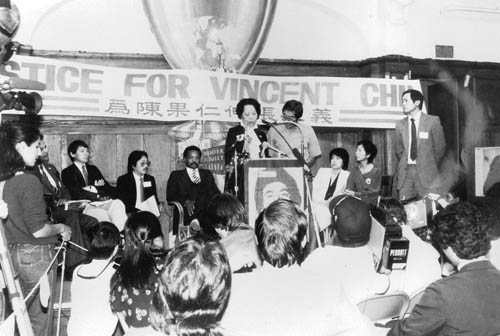
Caption: Courtesy of Christine Choy.
Filmmaking, whether fiction or documentary, long or short format, requires funding. This chapter considers approaches to financing media productions as well as the positive and negative consequences of funding agendas. The aim of the chapter is to provide filmmakers with a framework that can lead to ethical fundraising strategies at each stage of the preproduction, production, postproduction, and distribution process.
Take Home Points
- Budget and funding considerations can not only shape the films you make, but also the type of filmmaker you will become.
- Most times it is easier to acquire funding if you have an original story and exclusive access to that story. How you pursue finding an original story can have ethical implications.
- Being transparent about your funding decisions is not always an easy decision.
- Raising funds for sensitive media projects, including stories that can put the subject’s life at risk, require careful consideration of consequences.
- Before seeking funding, be sure you have thoroughly researched your topic. For feature length documentaries, two to three years of research and development is considered “thorough.”
- Contemporary funding sources often involve a privacy trade-off. Are you willing to make the privacy trade-off when using Crowdfunding and other internet sources?
References
Davies, A. P., & Wistreich, N. (2007). Film finance handbook: How to fund your film (digital edition, 2011). Glasgow, UK: Netribution.
Online
Bernstein, P. (2014, December 14). How do you make a living as an independent filmmaker? It's not easy. Retrieved from Indiewire: www.indiewire.com/article/how-do-you-make-a-living-as-an-independent-filmmaker-its-not-easy-20141216
Guay, R. (2015, February 7). Why we need diversity incentives for film and television. Retrieved from Indiewire: www.indiewire.com/article/why-we-need-diversity-incentives-for-film-and-television-20150207
Kang, C., Thompson, K., & Harwell, D. (2014, December 23). Hollywood’s race problem: An insular industry struggles to change. The Washington Post. Retrieved from www.washingtonpost.com/business/economy/hollywoods-race-problem-an-insular-industry-struggles-to-change/2014/12/19/d870df04-8625-11e4-9534-f79a23c40e6c_story.html
Liu, S. (2014, November 11). Three tips for diverse filmmakers seeking documentary funding. Retrieved from PBS: POV's Documentary Blog: www.pbs.org/pov/blog/news/2014/11/three-tips-for-diverse-filmmakers-seeking-documentary-funding/
Stout, H. (2015, June 21). Oh, to be young, millennial, and so wanted by marketers. The New York Times, Retrieved from page A1: www.nytimes.com/2015/06/21/business/media/marketers-fixation-on-the-millennial-generation.html?_r=0
Film
Alpert, J. & O’Neill, M. (Directors). (2009). China's unnatural disaster: Tears of Sichuan province [Documentary]. United States: HBO Films.
Amato, G. (Producer), & Sica, V. D. (Director). (1948). The bicycle thief [Motion Picture]. Italy: Ente Nazionale Industrie Cinematografiche.
Buñuel, L., Braunberger, P. (Producers), & Buñuel, L. (Director). (1929). Un chien Andalou [Motion Picture]. France: Les Grands Films Classiques.
Choy, C. (Director). (1989). Who killed Vincent Chin? [Documentary]. United States: Corporation for Public Broadcasting and WTVS. www.pbs.org/pov/whokilledvincentchin/
Choy, C. (Director) (1990). Best hotel on Skid Row [Documentary]. United States: HBO.
Choy, C. (Director) (1991). Homes apart: Two Koreas [Documentary]. United States: National Endowment for the Humanities, New York Council on the Humanities and New York State Council on the Arts. /www.pbs.org/pov/homesapart/
Choy, C. (Director). (1992). Jennifer’s in jail [Documentary]. United States: Lifetime Network.
Deren, M. (Producer), Deren, M., & Hammid, A. (Directors). (1943). Meshes of the afternoon [Motion Picture]. United States: Mystic Fire Video.
Godfrey, J., & Paik, N. J. (Directors). (1973). Global groove [Motion Picture]. United States: Electronic Arts Intermix. www.eai.org/title.htm?id=3287
Lerner, M. (Director). (1979). From Mao to Mozart: Isaac Stern in China [Documentary]. United States: Docurama.
Young, R. (Director). (2006). The blood of Yingzhou district [Documentary]. Smiley Film Sales.
Case Study
Case StudyDiscussion Questions
- What are the different possible sources of funding discussed by Choy?
- What kinds of agendas do funding agencies have?
- How do these competing agendas influence the filmmaker’s own vision?
- How did Choy alter how she made Who Killed Vincent Chin? in order to secure funding?
Chapter 3
Convergence of Journalism and Documentary
Lonnie Isabel
Summary

Credit: Tracing Tea/Shutterstock.com
Journalism and documentary have always been linked, and with the migration of news online, documentary journalism has seen a big resurgence. When journalists also become documentary filmmakers, and advocacy groups and citizen journalists—and almost anyone else with an image and text recording device and an internet connection—can commit an act of journalism, the lines of demarcation between professional journalism and other forms of media practice become blurry. Furthermore, as news organizations migrate online, the target audience not only changes, but also has different expectations than before. Coupled with economic cutbacks, the shift to digital journalism has resulted in experiments with new forms of multimedia journalism. This chapter describes the key features of this productive nexus of journalism and documentary, the challenges it poses for traditional codes of ethics, and the evolving response by professional organizations to the use of visual storytelling as part of online journalism.
Take Home Points
- Journalism and documentary have always been closely linked. As journalism migrates to the Internet more video storytelling has emerged that is akin to documentary
- Ethics is at the heart of journalism and strict codes have been developed that ensure accuracy, fairness and transparency. The amalgamation of journalism and documentary has placed new challenges upon journalists who make documentaries and documentarians who are increasingly practicing journalism.
- Much of the ethical discussion is still ongoing, ever-evolving and unsettled.
- Documentarians and journalists are trying to resolve conflicts over staging events, adding sound, and digital manipulation—all taboo to journalists.
References
Sperber, A. M. (1998). Murrow, his life and times. New York: Fordham University Press.
Online
Aufderheide, P., Jaszi, P., & Chandra, M. (2009). Honest truths: Documentary filmmakers on ethical challenges in their work. Retrieved from Center for Media & Social Impact: www.cmsimpact.org/sites/default/files/Honest_Truths_--_Documentary_Filmmakers_on_Ethical_Challenges_in_Their_Work.pdf
Das, A. (2015, February 1). Sundance 2015: Documentary or journalism? Retrieved from Center for Media & Social Impact: www.cmsimpact.org/blog/media-impact/sundance-2015-documentary-or-journalism
Estrin, J. (2014, February 16). The world’s best (unaltered) photos. The New York Times. Retrieved from http://lens.blogs.nytimes.com/2014/02/14/the-worlds-best-unaltered-photos/?_r=0
Kasson, E. G. (2010). The message is the medium: The difference between documentarians and journalists. Retrieved from International Documentary Association: www.documentary.org/magazine/message-medium-difference-between-documentarians-and-journalists
Kent, T. (n.d.) A customized ethics code for every organization. Retrieved from http://ethics.journalists.org/about/
NPPA. (n.d.). NPPA code of ethics. Retrieved from https://nppa.org/code_of_ethics
Olmstead, K., Mitchell, A., Holcomb, J., & Vogt, N. (2014, March 26). News video on the web: A growing, if uncertain part of news. Pew Research Center: State of the News Media. Retrieved from www.journalism.org/2014/03/26/news-video-on-the-web/
RTDNA. (2015). RTDNA code of ethics. Retrieved from www.rtdna.org/content/rtdna_code_of_ethics
Swimmer, J. (2004, September/October). Exchanging the pen for the camera: When journalists make the jump into documentaries. Retrieved from the International Documentary Association: www.documentary.org/magazine/echanging-pen-camera-when-journalists-make-jump-documentaries
Ward, S. J. A. (2013, August 19). Why we need a radical change for media ethics, not a return to basics. Retrieved from MediaShift www.mediashift.org/2013/08/why-we-need-radical-change-for-media-ethics-not-a-return-to-basics
Film
Alpert, J. & O’Neill, M. (Directors). (2008). Section 60: Arlington National Cemetery [Documentary]. United States: HBO. www.hbo.com/documentaries/section-60-arlington-national-cemetery/index.html
Hetherington, T. & Junger, S. (Directors). (2010). Restrepo (Documentary). Outpost Films. http://restrepothemovie.com/
Macrae, C. (Director). (2013). No Fire Zone: In the Killing Fields of Sri Lanka (Documentary). Israel: Cinephil. http://nofirezone.org/watch
Poitras, L. (Director). (2014). Citizenfour (Documentary). Praxis Films. https://citizenfourfilm.com/
Richen, Y. (Director). (2013). The New Black [Documentary]. United States: Promised Land Film Distribution. www.newblackfilm.com/
Case Study
Case StudyDiscussion Questions
- Why did early news documentaries like Murrow’s Harvest of Shame vanish from television?
- What changes in the media environment made documentaries produced by news organizations viable again?
- What are some sources of tension between documentary and journalism methods and styles?
- What are some similarities between documentary and journalism?
- What ethical concerns are raised by the rapid news cycle for online journalism?
Chapter 4
F-Stop: Power Differentials
Tami Gold
Summary

Caption: Courtesy of Tami Gold.
Power differentials can significantly impact all forms of media creation: fiction, documentary, journalism, and social media. This chapter explores power differentials in the relationship between the filmmaker and the people portrayed in documentaries. It looks at the principles of personal presentation, agency, equality, and power. I am using my experiences as a filmmaker to look at the ethics of consent, working with teenagers, screening rough-cuts, and the economic relationship between the filmmaker and the people in the films.
Take Home Points
- Collaboration and transparency are the foundations of ethical practice.
- Take the time to explain what it means to be the subject of a documentary film. Many people are eager and excited to tell their story, but do not understand that the film will been seen for many years by diverse and potentially expansive audiences.
- Demonstrate your understanding that you are an outsider and that you welcome their opinions and input.
- Be considerate and compassionate. The people in your documentaries are real people and subject to comments and criticism when the film is released. Remember this throughout the editing process.
- Paying someone to be in a documentary can appear to—or can actually result in—the interviewee saying what they think you want them to say since they are being paid. It is best and ethical to not pay the people who are in your documentary.
- The Personal Release Form is a legally binding contract. When interviewing people, take the time to explain why filmmakers need a signed release in order to use them in the film. Consider adjusting the Personal Release Form if someone requests his or her concerns to be added to the contract.
- Clearly explain the editing process and how the final edit will be determined. Be forthright about who has control and “final say” over the final cut of the movie. Discuss the importance of screening rough-cuts together and the final documentary before public viewings.
- All creative decisions have political implications. Remember “art is political.”
References
Anderson, C. (1981). The conundrum of competing rights in Titicut Follies. Journal of the University Film Association, 33(1), 15–22.
Cool, J., & Mulcihy, S. (2015). Working out the kinks: Anonymous subjects in ethnographic film. Anthropology Now, 7(2), 69–79.
Pryluck, C. (1976). Ultimately we are all outsiders: The ethics of documentary filming. Journal of the University Film Association, 28(1), 21–29.
Online
Cipriani, C. (2014, October 17). The ethics of documentary filmmaking. Indiewire. Retrieved from www.indiewire.com/article/the-ethics-of-documentary-filmmaking-20141017
Film
Anderson, K., & Gold, T. (Directors). (2004). Every mother’s son [Documentary]. United States: New Day Films. www.andersongoldfilms.com/beta/everymothersson/index2.html
Anderson, K., & Gold, T. (Directors). (1999). Making a killing: Philip Morris, Kraft and global tobacco addiction [Documentary], Corporate Accountability International Distributors. https://org.salsalabs.com/o/2215/t/12985/shop/item.jsp?storefront_KEY=629&t=&store_item_KEY=2283
Anderson, K., & Gold, T. (Directors). (1997). Out at work. United States: New Day Films and AndersonGold Films, Inc. www.andersongoldfilms.com/films/documentaries/oaw_au.htm
Gold, T., Gordon, D., & Lewis, E. (Directors). (1980). Signed, sealed and delivered: Labor struggle in the post office [Documentary]. United States: AndersonGold Films, Inc. www.andersongoldfilms.com/films/documentaries/ssd.htm
Gold, T. (Director). (1982). Looking for love: Teenage mothers [Documentary]. United States, AndersonGold Films, Inc. www.andersongoldfilms.com/films/documentaries/lfl.htm
Gold, T. (Director). (1992). Juggling gender: Politics, sex and identity [Documentary]. United States: AndersonGold Films, Inc. www.andersongoldfilms.com/films/documentaries/jg.htm
Pavlosky, D., & Gold, T. (Directors). (2014). Puzzles: When hate came to town [Documentary]. United States: New Day Films and AndersonGoldfilms, Inc. www.andersongoldfilms.com/films/documentaries/puzzles.htm
Case Study
Case StudyDiscussion Questions
- If the subject signs a consent form agreeing to allow his/her image and words to be used, does the filmmaker have any further ethical responsibility toward that subject? Can you think of any reasons why the subject might sign a consent form even if s/he is not fully comfortable with the idea?
- Gold discusses a number of cases—Puzzles, Making a Killing, Looking for Love—where she made different decisions regarding consent and privacy. How did she balance the public’s right to know with the subjects’ rights in each case?
Chapter 5
Identities: Race, Ethnicity, Gender, and Class Privilege
Yoruba Richen
Summary

Caption: Courtesy of Yoruba Richen.
This chapter investigates how race, gender, and class privilege shape and complicate media-making practice. Hollywood has been rightly criticized for its lack of diversity. While news and documentary media do feature stories about women and racial and ethnic minorities more often, there are still too few filmmakers and media producers of color telling and reporting on stories about their own communities. Thus, authenticity, the politics of representation, and the question of whose voice and perspective is privileged become central ethical concerns in documentary filmmaking. Furthermore, the lack of analysis about the position from which media is produced often results in the reinforcement of racial power positions, in addition to perpetuating stereotypical portrayals. Interviews with documentary filmmakers Grace Lee (The Grace Lee Project, 2005) and Annie Silverstein (March Point, 2008) and a description of the author’s own process in making The New Black (2013) offer readers a range of creative and ethical strategies that filmmakers can use to showcase authentic voices and to tell stories by and about communities that have been marginalized and traditionally underrepresented in the media.
Take Home Points
- Race/Gender/Class: your race, gender, or class position will influence how subjects/actors/interviewees respond to you. Being aware of your own position can also provide you with unique perspectives on certain issues.
- Stereotypes: when conceiving a media project, be aware of how easy it can be to fall back on stereotypes. Make sure the subjects/actors in your project are complex. Be sure to contextualize: where and how someone lives, as well as cultural variables, can provide viewers with greater understanding of story content and meanings.
- Crewing Up: be deliberate with crew selection. Pay careful attention to the racial and gender composition of the crew. This can make those in front of your camera more or less at ease. Consider selecting crew from the community your film is about. This can help establish greater trust and ease of communication.
- Process: if appropriate to your story, make sure your film reflects what the community wants or needs. Making movies, whether documentary or fiction, involves collaboration. Keep in mind that you are collaborating most with those in front of your camera. This includes individuals as well as communities.
- Audience: identify your audience and how you will get them to see your film. Think about what you want your audience to do after watching the film. This can include: grassroots activism, further discussion with others about issues raised, and opportunities to share their own stories.
- Outreach and Engagement: your involvement with the media project doesn’t end when the last scene is filmed. It is important to continue to remain connected with the subject. Arranging film festival screenings, as well as educational events and speaking engagements can insure that the issues raised in the film are brought to a wider audience.
References
Klotman, P. R., & Cutler, J. K. (Eds.). (1999). Struggles for representation: African American documentary film and video. Bloomington: Indiana University Press.
Mulvey, L. (1975). Visual pleasure and narrative cinema. Screen 16(3), 6–18.
Rabiger, M. (2009). Directing the documentary (6th ed.). Burlington MA: Focal Press.
Online
Bernard, S. C. (2011). Documentary storytelling (3rd edition). Burlington, MA: Focal Press.
Brewster, J., & Stephenson, M. (2015, April 25). Hollywood: The power of the white gaze. The Huffington Post.Retrieved from www.huffingtonpost.com/joe-brewster/hollywood-the-power-of-th_b_6738578.html
Buckley, C. (2015, May 12). ACLU, citing bias against women, wants inquiry into Hollywood’s hiring practices. The New York Times. Retrieved from www.nytimes.com/2015/05/13/movies/aclu-citing-bias-against-women-wants-inquiry-into-hollywoods-hiring-practices.html
Color of Change. (2015, March). Not to be trusted: Dangerous levels of inaccuracy in TV crime reporting in NYC. Retrieved from https://s3.amazonaws.com/s3.colorofchange.org/images/ColorOfChangeNewsAccuracyReportCardNYC.pdf
Edwards, G. (2015, January 5). We shall overcome: Ava DuVernay on making Selma. Rolling Stone. Retrieved from www.rollingstone.com/movies/features/ava-duvernay-on-making-selma-20150105
Horn, J., Sperling, N., & Smith, D. (2012). Unmasking the Academy: Oscar voters overwhelmingly white, male. The Los Angeles Times.Retrieved from www.latimes.com/entertainment/envelope/oscars/la-et-unmasking-oscar-academy-project-20120219-story.html#page=1
Juzwiak, R. (2015, May 14). Paris is Burning screening sparks furor, calls for boycott. Defamer. Retrieved from http://defamer.gawker.com/paris-is-burning-screening-sparks-furor-calls-for-boyc-1704488524
Kang, J. C. (2015, May 4). “Our demand is simple: Stop killing us.” How a group of black social media activists built the nation’s first 21st-century civil rights movement. The New York Times Magazine. Retrieved from www.nytimes.com/2015/05/10/magazine/our-demand-is-simple-stop-killing-us.html?_r=0
Khatchatourian, M. (2015, May 12). Hollywood’s “biased” hiring practices against women subject of ACLU inquiry. Variety. Retrieved from http://variety.com/2015/biz/news/hollywoods-biased-hiring-practices-against-women-subject-of-a-c-l-u-inquiry-1201493101/
O’Hara, M. E. (2015, May 13). Why are LGBT people of color protesting the screening of this cult film classic? The Daily Dot. Retrieved from www.dailydot.com/lifestyle/paris-is-burning-facebook-lgbtq-controversy/
Papper, B. (2014, July 28). Women, minorities make newsroom gains. The Radio Television Digital News Association. Retrieved from www.rtdna.org/article/women_minorities_make_newsroom_gains#.VXx4BlVVikp
Richen, Y. (2015, January 20). #OscarSoWhite includes the documentary category, too. Women and Hollywood. Retrieved from http://blogs.indiewire.com/womenandhollywood/guest-post-oscarsowhite-includes-the-documentary-category-too-20150120
Silverstein, M. (2013, January 21). Sundance Institute and Women in Film release unprecedented study on women directors. Women and Hollywood. Retrieved from http://blogs.indiewire.com/womenandhollywood/sundance-institute-and-women-in-film-release-unprecedented-study-on-women-directors
Wildermuth, J. (n.d.). Black support for prop. 8 called exaggeration. SF Gate.com. Retrieved from www.sfgate.com/politics/article/Black-support-for-Prop-8-called-exaggeration-3177138.php
Film
DuVernay, A. (Director). (2014). Selma [Motion Picture]. Paramount Pictures.
Lee, G. (Director). (2005). The Grace Lee Project [Documentary]. Women Make Movies. http://gracelee.net/GraceLee.m4v. The clip referenced in the chapter is from 12:15 to 14:34.
Livingston, J. (Director). (1990). Paris is Burning [Documentary]. United States: Miramax. https://www.jennielivingston.com/paris-is-burning
Richen, Y. (Director). (2013). The New Black [Documentary]. United States: Promised Land Film Distribution. www.newblackfilm.com/
Clips from The New Black referenced in the chapter are available on Vimeo. The password is “pressclips”
“Michelle”: https://vimeo.com/68252396
“The Black Church”: https://vimeo.com/68250960
Riggs, M. (Director).(1994). Black is… Black Ain’t [Motion Picture]. Newsreel. http://newsreel.org/video/BLACK-IS-BLACK-AINT
Silverstein, A., & Rector, T. (Directors). (2008). March Point [Documentary]. Long House Media/Independent Lens. http://itvs.org/films/march-point
The clip from March Point referenced in the chapter is available on Vimeo: https://vimeo.com/28959731
Taylor, T. (Director). (2011). The Help [Motion Picture]. Walt Disney Studios Motion Pictures.
Case Study
Case StudyDiscussion Questions
- Why, according to Richen, is it important to have filmmakers and media producers of color telling stories about people of color?
- What does “authentic” storytelling look like? Is Selma an example of authentic storytelling?
- Why did both Richen and Lee aim for a diversity of voices in their documentaries?
- How was Richen both an insider and an outsider in the communities featured in her documentary The New Black? How did she navigate her own position in relation to these communities?
- What were Annie Silverstein’s main ethical concerns about making a film as an outsider to the community?
Chapter 6
Ethical Challenges for the Cinematographer
Scott Sinkler
Summary
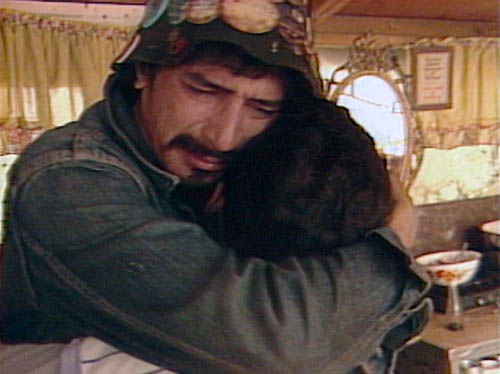
Caption: Courtesy of Scott Sinkler.
This chapter looks at the ethics of making media from the perspective of the photographer or cameraperson. When real-life issues arise, there will often be competing considerations that the cameraperson will have to weigh and balance The camera is the portal between the real world and the media universe—the exact location where fleeting events are frozen in time and engraved into the permanent record.
Take Home Points
- The photographer or cameraperson may face unexpected ethical issues, so it is important to have the principles in mind before shooting.
- It is the documentary cameraperson’s responsibility to strive for truth, accuracy, and fairness in depicting people and events.
- Staging events as real is ethically problematic, but occasionally some intervention is required for the sake of filming. The important thing is that people or events are not misrepresented in the process.
- Context is important in framing reality. You can’t film everything; what you exclude can be as important as what you include.
- Filming without consent with a hidden camera is against the law and is almost always unacceptable.
- The photographer needs to ask whether his or her images are perpetuating stereotypes of social groups.
- When weighing the public’s right to know against institutional rules and policies against filming, consider the potential consequences to yourself and—especially—to the people in front of the camera.
- Encroaching on a subject’s privacy or the public disclosure of private facts can be harmful and must be handled sensitively, particularly with vulnerable populations.
- Unless uncovering criminal or unethical behavior of sufficient public interest, filming that is harmful to individuals is always unacceptable.
References
Cunningham, M. (2014). The art of the documentary: Fifteen conversations with leading directors, cinematographers, editors, and producers (2nd ed.). San Francisco, CA: New Riders Press.
Lester, P. (2015). Photojournalism: An ethical approach. London, UK: Routledge.
Newton, J. (2000). The burden of visual truth: The role of photojournalism in mediating reality. London, UK: Routledge.
Palmer, C. (2015). Confessions of a wildlife filmmaker: The challenges of staying honest in an industry where ratings are king. Bluefield, WV: Bluefield Publishing.
Quinn, J. (2015). Adventures in the lives of others: Ethical dilemmas in factual filmmaking. London, UK: I. B. Tauris.
Thomas, G., Ibbotson, J., & Leonard, E. (2015). Beyond the lens: rights, ethics and business practice in professional photography. London, UK: Proving House LLP.
Winston, B. (2000). Lies, damn lies and documentaries. London, UK: British Film Institute.
Online
Aufderheide, P., Jaszi, P., & Chandra, M. (2009). Honest truths: Documentary filmmakers on ethical challenges in their work. Center for Social Media. Washington, DC. Retrieved from www.cmsimpact.org/making-your-media-matter/documents/best-practices/honest-truths-documentary-filmmakers-ethical-chall
Bernstein, R. (1985, October 20). Shoah (1985): An epic film about the greatest evil of modern times. The New York Times. Retrieved from www.nytimes.com/movie/review?res=9805E5DC1E39F933A15753C1A963948260
Brook, P. (2010, January 27). Fabienne Cherisma. Prison Photography. Retrieved from http://prisonphotography.org/2010/01/27/fabienne-cherisma/
Folkenflik, D. (2014, November 22). In NPR and AP Cosby interviews, a “No comment” that said everything. NPR. Retrieved from www.npr.org/2014/11/22/365828829/in-npr-and-ap-cosby-interviews-a-no-comment-that-said-everything
Harris, M. (2015, April 3). Photographer who took iconic Vietnam photo looks back, 40 years after the war ended. Vanity Fair. Retrieved from www.vanityfair.com/news/2015/04/vietnam-war-napalm-girl-photo-today
Koehler, D. (2012). Documentary and ethnography: Exploring ethical fieldwork models. The Elon Journal of Undergraduate Research in Communications, 3(1). Retrieved from https://www.elon.edu/docs/e-web/academics/communications/research/vol3no1/06KoehlerEJSpring12.pdf
Patchin, J. (2015). Summary of our cyberbullying research (2004–2015). Cyberbullying Research Center. Retrieved from http://cyberbullying.org/summary-of-our-cyberbullying-research/
Poe, E.A. (1840, January 15). The daguerreotype. Alexander’s Weekly Messenger. Philadelphia. Retrieved from www.daguerreotypearchive.org/texts/P8400008_POE_ALEX-WEEKLY_1840-01-15.pdf
Pramis, J. (2013, February 28). Number of mobile phones to exceed world population by 2014. Digital Trends. Retrieved from www.digitaltrends.com/mobile/mobile-phone-world-population-2014
Sample, I. (2014, October 09). 35,000 year-old Indonesian cave paintings suggest art came out of Africa. The Guardian. Retrieved from www.theguardian.com/science/2014/oct/08/cave-art-indonesia-sulawesi
Sen, I. (2013, May 10). The Michael Moore of the grade-school lunchroom. The New York Times. Retrieved from http://cityroom.blogs.nytimes.com/2013/05/09/the-michael-moore-of-the-grade-school-lunchroom/?_r=0
This is 15-year-old Fabienne Cherisma, shot dead by a policeman after looting three picture frames. (2013, April). Colors. Retrieved from www.colorsmagazine.com/stories/magazine/86/story/this-is-15-year-old-fabienne-cherisma-shot-dead-by-a-policeman-after-lootin
Winston, B. (1999). Documentary: How the myth was deconstructed. Wide Angle, 21 (2). Retrieved from www.der.org/resources/study-guides/how-the-myth-brian-winston.pdf
Zhang, M. (2012, September 19). Interview with Nick Ut, the photojournalist who shot the iconic “Napalm girl” photo. PetaPixel. Retrieved from http://petapixel.com/2012/09/19/interview-with-nick-ut-the-photojournalist-who-shot-the-iconic-photo-napalm-girl/
Film
Davis, P. (Director). (1974). Hearts and Minds (Documentary). Warner Brothers.
Flaherty, R. J. (Director). (1922). Nanook of the North: A Story of Life and Love in the Actual Arctic (Documentary). United States: Reel Media International. https://archive.org/details/nanookOfTheNorth1922
Flaherty, R. J. (Director). (1934). Man of Aran (Documentary). United States: Park Circus. https://archive.org/details/manOfAran1934
Gilbert, C. (Director). (1973). An American Family (Documentary). Public Broadcasting Service. www.thirteen.org/american-family/
Hamada, S., & Sinkler, S. (Directors). (1988). Inside Life Outside (Documentary). Scott Sinkler.
Lanzmann, C. (Director). (1985). Shoah (Documentary). France: Why Not Productions.
Maxwell, Z. (Director). (2012). Yuck: A 4th Grader’s Short Documentary About School Lunch (Documentary). Maxwell Project. https://vimeo.com/43793321
Ophüls, M. (Director). (1969). The Sorrow and the Pity (Documentary). Oscilloscope Pictures.
Soechtig, S. (Director). (2014). Fed Up (Documentary). RADiUS-TWC.
Stoney, G. C. (Director). (1978). How the Myth Was Made: A Study of Robert Flaherty’s Man of Aran (Documentary). United States: Park Circus.
Westrate, E. (Director). (2004). A Family Undertaking (Documentary). Fanlight Productions.
Case Study
Case StudyDiscussion Questions
- Sinkler discusses the standards for acceptability for staging events in documentary. As he says, most documentarians strike a working balance between complete non-interference and some rearranging for aesthetic reasons. But, if as common sense suggests that simply recording “real life” will naturally influence what’s happening, “are not the conventions of the mute and unobtrusive film crew, and the subject who avoids looking into the camera, in some ways dishonest?” What do you think? Under what conditions does it become unethical to pretend the camera is not there?
- Some of the most powerful visual images are those that capture moments of tragedy and suffering. These unavoidably raise concerns about exploitation. According to Sinkler: “The ethical quandaries arise in the space between one person’s suffering and another’s benefit from it, whether it’s advancing the filmmaker’s career or affording the viewer some kind of voyeuristic pleasure or vicarious thrill.” Sinkler is talking here about documentary film and journalism. Do you think the same rules apply to reality television programs where real people have agreed to be on camera?
Chapter 7
Technical Framing
Annette Danto
Summary

Credit: Courtesy of Ilango Samuel Peter.
This chapter offers you advice on how to make effective and ethical choices with technical framing. Your choices determine how subjects and objects are incorporated in specific shots; both directly and indirectly. For text-based media, selection of headlines and words become framing determinants. Technical framing choices always produce specific readings. Shot size, camera angle, composition, lighting and exposure, static or moving images determine patterns of inclusion and exclusion. In all media forms, technical framing regulates what the audience will see, understand, and experience.
Take Home Points
- You don’t have to tell all the details of the project’s goals when investigating injustices.
- When misrepresentation is used for publicity purposes, the results often backfire. Once an audience learns they have been deceived, their trust in media creators erodes.
- Shot selection is consequential in how an audience understands and experiences media content.
- Being intentional with eye lines can communicate a theme to your audience quickly and with intensity. This positioning matters. It alters the relationship between the subject and the audience.
- Aesthetic decisions can be intuitive and made with little forethought. Ethical choices and decisions must be made, at times, instantaneously and instinctively.
- By playing with background–foreground emphasis, technical framing and reframing maneuvers produce shifts in information provided to viewers. Technical framing of similar events becomes the essential factor for demonstrating shifting perspectives.
- When working with actors, threats and actions designed to impose power as a way of creating a more compelling on-camera performance is unethical.
- Creating media on a low budget does not by itself determine moral superiority.
- Whether a media project is well-funded, or not, drawing audience attention to technical innovation by itself is unrelated and has no bearing on the ethical content of the story.
References
Adams, A. (2014, July 14). The celebration. Retrieved from Examiner.com: www.examiner.com/article/idie-gold-the-celebration July 14
Benson, T. W., & Anderson, C. (2002). Reality fictions: The films of Frederick Wiseman. Carbondale, IL: Southern Illinois Univ. Press.
Crane, S. A. (2008). Choosing not to look: Representation, repatriation, and Holocaust atrocity photographs. History and Theory, 47(3), 309–330.
Hüppauf, B. (1997, October). Emptying the gaze: Framing violence through the viewfinder. New German Critique (72), 3–44.
Kapur, J. (1997). The art of ethnographic film and the politics of protesting modernity: Robert Gardner’s forest of Bliss. Visual Anthropology, 9(2), 167-185.
Keilbach, J. (2009). Photographs, symbolic images and the Holocaust: On the (im)possibility of depicting historical truth. History and Theory, 48(2), 54–57.
Rabiger, M. (2015). Directing the documentary (6th ed.). Burlington, MA: Focal Press.
Sontag, S. (1977). On photography. New York, NY: Farrar, Straus and Giroux.
Sontag, S. (2003). Regarding the pain of others. New York, NY: Farrar, Straus and Giroux.
Online
Aufderheide, P., Jaszi, P., & Chandra, M. (2009). Honest truths: Documentary filmmakers on ethical challenges in their work. Retrieved from Center for Media & Social Impact: www.cmsimpact.org/making-your-media-matter/documents/best-practices/honest-truths-documentary-filmmakers-ethical-chall
Billson, A. (2013, November 4). Why do some film directors abuse their actors? The Telegraph. Retrieved from www.telegraph.co.uk/culture/film/10411273/Why-do-some-film-directors-abuse-their-actors.html
Chappel, B. (2004, October 27). As time closes in: A conversation with Errol Morris. Gothamist. Retrieved from Errol Morris: http://errolmorris.com/content/interview/gothamist1004.html
Darnton, N. (1986, March 9). How 9 1/2 weeks pushed an actress to the edge. The New York Times.Retrieved from www.nytimes.com/1986/03/09/movies/how-9-1-2-weeks-pushed-an-actress-to-the-edge.html?pagewanted=all
Dogme95.dk—A tribute to the official Dogme95. (n.d.). Retrieved from Dogme95.dk: www.dogme95.dk/
Nitrategeek. (2011, October 23). The shining [web log post]. Retrieved from Stories Behind the Screen: https://storiesbehindthescreen.wordpress.com/tag/shelley-duvall/
Oglethorpe, T. (2012, December 21). Hitchcock? He was a psycho: As a TV drama reveals his sadistic abuse, Birds star Tippi Hedren tells how the director turned into a sexual predator who tried to destroy her. The Daily Mail Online.Retrieved from www.dailymail.co.uk/tvshowbiz/article-2251425/Tippi-Hedren-tells-Alfred-Hitchcock-turned-sexual-predator-tried-destroy-her.html
Russell, C. (1990). Cane fields bearing an ugly harvest. Sun Sentinel. Retrieved from http://articles.sun-sentinel.com/1990-11-04/features/9002230466_1_migrant-workers-jamaicans-sugar
Scott, A. O. (2004, May 26). The Five Obstructions (2003): A cinematic duel of wits for two Danish directors. The New York Times. Retrieved from www.nytimes.com/movie/review?res=9C02E4D6143EF935A15756C0A9629C8B63
The director must not be credited: 20 years of Dogme 95. (2015, August). Retrieved from the Museum of Art and Design: http://madmuseum.org/series/director-must-not-be-credited-20-years-dogme-95
The vow of chastity. (n.d.). Retrieved from www.dogme95.dk/the-vow-of-chastity/
Williams, M. E. (2014, June 13). Horror’s first viral hit: How “The Blair Witch Project” revolutionized movies. Salon.Retrieved from www.salon.com/2014/06/13/horrors_first_viral_hit_how_the_blair_witch_project_revolutionized_movies/
Film
Black, S. (Director). (1990). H2 Worker [Motion Picture]. United States: Lionsgate. www.docurama.com/docurama/h-2-worker/
Danto, A., (Director). (2004). Shanti’s story [Motion Picture]. Belgaum, Karnataka, India: Pathfinder International. A 20-minute clip is available at www.youtube.com/watch?v=vSTFlknkQ3k
Danto, A. (Director). (2011). Reflections on media ethics [Documentary]. San Francisco, California: Forwardintime.com. www.forwardintime.com/store/p161/Reflections_On_Media_Ethics_%282011%29.html
Danto, A., & Ilango, S. P. (Director). (2003). A daughter’s letter [Music Video]. Madurai, Tamil Nadu: Gandhigram Institute of Rural Health and Family Welfare Trust.
Gardner, R., & Ostor, A. (Directors). (1986). Forest of Bliss [Documentary]. United States: Film Forum Distributors. www.der.org/films/forest-of-bliss.html
Maysles, A., Maysles D., & Zwerin, C. (Directors). (1969). Salesman [Documentary]. United States: Maysles Films.
Maysles, A., Maysles, D., Hovde, E., Meyer, M., & Froemke, S. (Directors). (1976). Grey gardens [Documentary]. United States: Maysles Films.
Morris, E. (Director). (2003). Fog of war: Eleven lessons from the life of Robert S. McNamara [Motion Picture]. Sony Classics, U.S.A.
Myrick, D., & Sanchez, E. (Directors). (1999). The Blair Witch Project [Motion Picture]. Lionsgate and Haxan Entertainment. www.blairwitch.com/
Case Study
Case StudyDiscussion Questions
- What is “technical framing”?
- What are the main ethical questions to keep in mind when composing a shot?
- How can your choice of camera angle influence audience perception?
- What does it mean to think of the camera as a “witness”? If, as Danto asks, “recording images of victimization [can] perpetuate the degradation by creating a permanent record,” how can the camera act as an ethical witness?
- Danto discusses the “Vow of Chastity” that is part of the Danish filmmaking movement called Dogme 95. What ethical values—if any—are expressed in this commitment to certain technical parameters?
Chapter 8
To Zoom or Not to Zoom
Jon Alpert
Summary
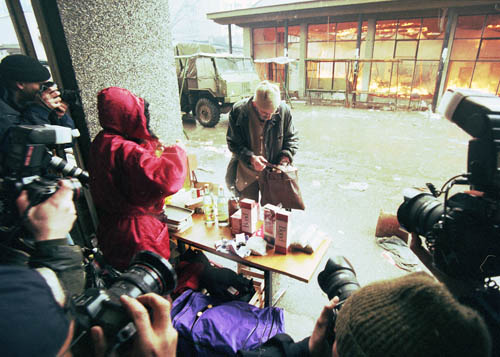
Credit: Northfoto/Shutterstock.com
This chapter is an edited transcript of the keynote address by Jon Alpert at Brooklyn College on March 14, 2013, as part of the Global Media Ethics Conference. Alpert explores the role of the cinematographer/journalist in documentary production with a focus on war photography. In a chaotic environment, you have to make split-second decisions about your subject’s right to privacy and about whether to remain objective or get involved. These decisions can have serious, even life-and-death, consequences. Through numerous examples from his experiences in Vietnam, Cambodia, Cuba, and the Philippines, Alpert explains the complex ethical decision-making that often occurs when you try to find a balance between obligations to your subjects and an audience’s right to know.
Take Home Points
- Unpredictable things happen when you are in the field as a reporter, or working on a documentary. Nonetheless you must be prepared to quickly consider the ethical complexities even when you don’t have a lot of time.
- When covering breaking news, you often have to make instant decisions about the public’s right to know and an individual’s right to privacy. These decisions have to be made with restraint and sensitivity.
- We want to understand what is happening in different parts of the world. We want to understand how people are feeling in conflict zones. But we need to recognize that there are certain boundaries media-makers need to understand and honor.
- When covering war and conflict, it is sometimes hard to stay neutral. You must decide when you have to do something to help another person. This reality can put your role as a reporter tasked with “getting the story,” and being a human being into conflict.
References
Keith, S., Schwalbe, C. B., & Silcock, B. W. (2006). Images in ethics codes in an era of violence and tragedy. Journal of Mass Media Ethics, 21(4), 245–264.
Mirzoeff, N. (2012). Watching Babylon: The war in Iraq and global visual culture. Abingdon: Routledge.
Online
Sanchez, R. (2013, December 29). Conn. police release final report on Newtown school shooting. CNN. Retrieved from www.cnn.com/2013/12/27/justice/connecticut-newtown-shooting-report/
Film
Alpert, J., & O’Neill, M. (Directors). (2008). Section 60: Arlington National Cemetery [Documentary]. United States: HBO. www.hbo.com/documentaries/section-60-arlington-national-cemetery/index.html
Alpert, J., & O’Neill, M. (Directors). (2009). China’s unnatural disaster: The tears of Sichuan Province [Documentary]. United States: Downtown Community Television (DCTV) and HBO. www.hbo.com/documentaries/chinas-unnatural-disaster-tears-of-sichuan-province
Alpert, J., & O’Neill, M. (Directors). (2012). In Tahrir Square: 18 days of Egypt’s unfinished revolution [Documentary]. United States: HBO. www.hbo.com/documentaries/in-tahrir-square-18-days-of-egypts-unfinished-revolution
Danto, A. (Director). (2011). Reflections on media ethics [Documentary]. San Francisco, California: Forwardintime.com. www.forwardintime.com/store/p161/Reflections_On_Media_Ethics_%282011%29.html
Case Study
Case StudyDiscussion Questions
- How does Alpert balance the idea that, in a democracy, the public has the “right to know” about important issues with the individual subject’s “right to privacy”?
- As a cinematographer, you might have to make split-second decisions in a complex and chaotic environment. What do you think of Alpert’s decisions to help the Vietnamese woman in the ODP?
- How did the presence of the camera alter what Alpert was able to do when he visited the Vietnamese prison camp?
- How did Alpert balance different ethical obligations in his story on the Mariel Bay Boatlift? Do you think he made the right decisions?
Chapter 9
Hidden Camera: A Conversation on Surveillance
Samir Chopra with Mobina Hashmi
Summary
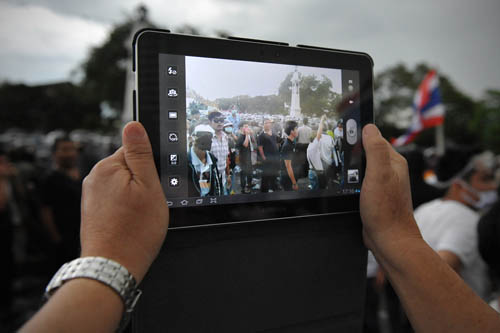
Caption: Credit: 1000 Words/Shutterstock.com
This chapter is an edited transcript of a conversation with philosopher and computer scientist Samir Chopra, who defines surveillance as an asymmetric power relation between the observer and observed where the observer gathers and uses information for political, legal, or social purposes that the observed does not necessarily consent to or even know about. Chopra describes how the asymmetrical power relations between the observer and observed that define surveillance, structure our experiences as citizens, consumers, and media practitioners and audiences or users. He identifies transparency, accountability, and consent as the core ethical concerns raised by pervasive media surveillance. Instead of the exclusive focus on privacy, he suggests that a more productive line of thinking centers on asking what kinds of lives are enabled or made impossible by surveillance? Not only does the surveillance of citizens and government secrecy damage the freedom necessary for a democratic society, but also new forms of social media create a form of peer surveillance and pose new ethical challenges about sharing private information.
Take Home Points
- Surveillance is the gathering of information in the context of an asymmetrical power relation about people for uses that may not be clear to them. It thus violates the ethical principles of transparency and informed consent.
- Keep the principle of respect for others’ privacy in mind even when there is no legal requirement to do so.
- Commercial social media platforms are designed to encourage the kinds of interactions and sharing that generate data that will be valuable to advertisers and marketers. As media creators, choose a social media platform that best reflects your own ethical commitments to privacy. Inform your audience of how their information will be used.
- Social media platforms also make it easier to engage in peer-to-peer surveillance. Just because you can gather information about friends, colleagues or even strangers does not mean you should.
- Ordinary citizens and media creators can sometimes reverse the gaze and engage in surveillance or monitoring those in positions of power. If you do this, be mindful of the consequences to yourself and to those whose information or images you collect and share. Carefully consider if your actions are necessary for the public good.
- When the government or corporations gather information about us through tracking our online behavior, we cannot give informed consent. It is detrimental to democratic participation because while your information might be taken from you, information about the government or corporations is increasingly protected in the name of security or through the creation of intellectual property.
- New media technologies can enable new forms of community, creative expression, and lifestyles. But, altered notions of privacy, including the pressure to live more and more of our lives in public, can also make certain other forms of identity and community more difficult. Be respectful of different ways of creating and managing online identities and communities as you craft your own social media presence.
References
Cheney-Lippold, J. (2011). A new algorithmic identity soft biopolitics and the modulation of control. Theory, Culture & Society, 28(6), 164–181.
Chopra, S., & Dexter, S. D. (2008). Decoding liberation: The promise of free and open source software. London: Routledge.
Chopra, S., & White, L. F. (2011). A legal theory for autonomous artificial agents. University of Michigan Press.
Lupton, D. (2013). Quantifying the body: Monitoring and measuring health in the age of mHealth technologies. Critical Public Health, 23(4), 393–403.
Mann, S. (2005). Sousveillance and cyborglogs: A 30-year empirical voyage through ethical, legal, and policy issues. Presence, 14(6), 625–646.
Online
Farivar, C. (2015, October 5). Facing a strong backlash, person-rating app Peeple seemingly vanishes. Ars Technica. Retrieved fromhttp://arstechnica.com/business/2015/10/yelp-for-people-app-if-it-exists-disappears-from-the-internet/
See Samir Chopra’s blog Refusing to Stick to the Subject for more on:
- Privacy: http://samirchopra.com/tag/privacy/
- Facebook: http://samirchopra.com/tag/Facebook/
- Surveillance: http://samirchopra.com/tag/Surveillance/
Film
Gilbert, C. (Director). (1973). An American Family (Documentary). Public Broadcasting Service. www.thirteen.org/american-family/
Poitras, L. (Director). (2014). Citizenfour (Documentary). Praxis Films. https://citizenfourfilm.com/
Case Study
Case StudyDiscussion Questions
- How does Chopra define surveillance? How is it different from other kinds of information gathering like in research or by journalists?
- What is the difference between “hidden camera” surveillance and digital surveillance?
- What defense does Chopra offer for Edward Snowden’s and Chelsea Manning’s actions? Do you agree?
- What is the value of privacy according to Chopra? How do social media alter our interactions with others?
- As a media-maker trying to publicize your own work using social media, what ethical guidelines should you follow?
Chapter 10
The Ethics of Sound
John Gurrin
Summary
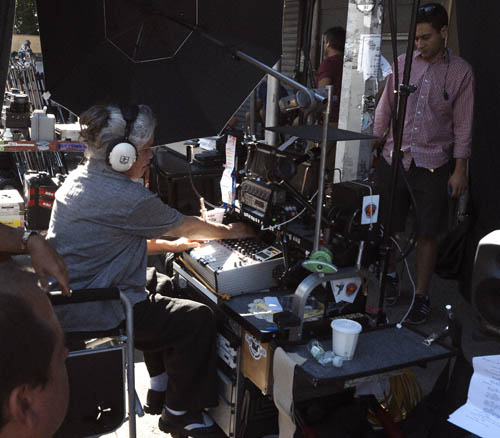
Credit: Courtesy of Alex Milne.
This chapter provides a framework for the ethical use of dialogue, music, and sound effects in narrative and non-fiction media-making. How do technical and creative sound choices influence audience perception of a story? By examining the use of sound in public/private space, on-location recording, sound design, and sound editing, this chapter will offer guidance in the ethical use of sound for media creation.
Take Home Points
- Dialogue, music, and sound effects are powerful creative tools for media-makers; often affecting the audience on an unconscious level. Sound has a direct impact on visual storytelling and can effectively manipulate audience reactions.
- When selecting music, be sure to carefully consider the emotional subtext of the music itself as well as of the lyrics. Keep in mind that when dealing with global internet distribution, there are cultural variations in the interpretation of musical tone, expression, and lyrics.
- Equipment selection can have ethical implications. Hidden microphones, wireless body mics on actors, and camera microphones need to be used with care.
- Remember that music is not simply an “object” to be used. It is the creative work of an artist who should be respected.
- Hidden cameras and planted microphones can present significant ethical dilemmas. Issues of disclosure, recording when someone is unaware of the camera/sound, and consent are important elements for the sound recordist to carefully consider before participating in productions requiring surveillance-style/covert media-making.
References
Holman, T., & Baum, A. (2013). Sound for digital video (2nd ed.). Burlington, MA: Focal Press.
Miles, D. (2015). Location audio simplified: Capturing your audio ... and your audience. New York, NY: Focal Press.
Saltzman, S. (2014). Music editing for film and television: The art and the process. Burlington, MA: Focal Press.
Online
Tompkins, A. (2002, July 28). Sliding sound, altered images. Retrieved from www.poynter.org/uncategorized/1466/sliding-sound-altered-images/
Film
Guggenheim, D. (Director) and Gore, A. (Writer). (2006). An inconvenient truth [Documentary]. United States: Paramount Classics. www.takepart.com/an-inconvenient-truth/film
Jarecki, A. (Director). (2003). Capturing the Friedmans [Documentary]. United States: HBO/Magnolia Pictures.
Jarecki, A. (Director). (2015). The Jinx: The life and deaths of Robert Durst [Documentary]. United States: HBO. www.hbo.com/the-jinx-the-life-and-deaths-of-robert-durst
Case Study
Case StudyDiscussion Questions
- Gurrin notes that in Foley sound “[e]verything—from footsteps to the rustle of clothing, from door creaks to street ambiences—is chosen, not for its verisimilitude, but for what it sounds and feels like.” Here “authenticity” is about accurately reproducing what the real object sounds like. If this is the case, why is Foley sound not acceptable for documentaries and news stories as well?
- What are the ways in which the production sound recordist can ensure the actors’ privacy on set?
- What is the difference between the ethical use of music in fiction and in documentary film?
- Why is a boom microphone a better choice than a lavalier?
- Under what conditions is a super-cardioid microphone a better choice than a shotgun microphone?
Chapter 11
The Editor: A Story’s Advocate
Terilyn A. Shropshire
Summary
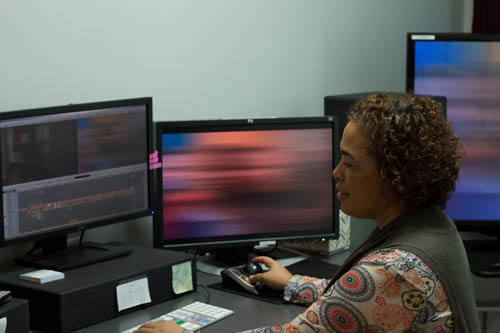
Caption: Courtesy of Michael Chernak.
Whether editing your own project or working as a hired editor facilitating a filmmaker's vision, your creative skills, personal instincts, professional behavior, and moral compass will be called into action on a daily basis. This chapter will explore the various ethical dilemmas editors encounter as we take a story through its unpredictable evolution in the editing room. This includes the importance of an editor’s point of view during production, defining and redesigning the visual narrative, the politics of collaboration, boundaries of accuracy and navigating the ratings board.
Take Home Points
- As editor, you are the story’s advocate and the early audience for the material. Communicate and collaborate in service to that responsibility.
- As the story evolves through the editing process, you must be receptive to the inevitable changes that will occur. Overcome your attachment to what exists and be open to other possibilities.
- Prepare yourself to navigate the unpredictable politics that are part of every editing room. Trust your voice and internal governor to guide you through the more ethically challenging situations.
- The best ethical advice any editor can give you is: pay attention to what you are feeling and what your instincts are telling you. It is important for you to have your individual opinion, even if it is not in sync with others.
- You are in the room to offer perspective with a balance of ego and humility. You have to live with the decisions you make. Practice discretion and be respectful of other collaborators’/artists’ perspectives.
- It is crucial to be honest with your creative collaborators. Be forthright about what works, and what doesn’t.
References
Betancourt, M. (2016). Beyond spatial montage: Windowing, or the cinematic displacement of time, motion, and space. Burlington, MA: Focal Press.
Gordon, A. D., Kittross, J. M., Merrill, J. C., & Babcock, W. (2011). Controversies in media ethics (3rd ed.). New York, NY: Routledge.
Harris, K. M. (2006). Boys, boyz, bois: An ethics of Black masculinity in film and popular media. New York, NY: Routledge.
Murch, W. (2001). In the blink of an eye: A perspective on film editing (2nd ed.). Los Angeles, CA: Silman-James Press.
Ondaatje, M. (2002). The Conversations: Walter Murch and the Art of Editing. Great Britain: Bloomsbury Publishing.
Perebinossoff, P. (2008). Real-world media ethics: Inside the broadcast and entertainment industries. Amsterdam, NL, & Boston, MA: Focal Press.
Online
Cinema Editor: The Magazine for Film & Television Editors, Assistants and Post-Production Professionals, for example, is available online for a very reasonable fee at https://americancinemaeditors.org/ce-magazine1116/
Film
Blythewood, G. P. (Director). (2000). Love and basketball [Motion Picture]. New Line Cinema.
Hampton, H. (Executive Producer). (1987–1990). Eyes on the prize [Motion Picture]. Public Broadcasting System.
Lemmons, K. (Director) (1997). Eve’s Bayou [Motion Picture]. Trimark Pictures.
Poitras, L. (Director). (2014). Citizenfour [Motion Picture]. HBO Films/Radius-TWC. https://citizenfourfilm.com/
Case Study
Case StudyDiscussion Questions
- According to Shropshire, what are the different ethical obligations of the editor? Under what circumstances can these obligations come into conflict?
- What are the guiding ethical principles for a successful collaboration between the editor and others involved in creating a film?
- Lillian Benson and Sam Pollard both describe how they handled a conflict over the ethics of representation. What were the similarities and differences in their approach? Did their decisions reflect the same understanding of their role as editor or not?
- What, according to Lane Baker, is a “frankenbite”? How and when is this practice ethical in reality television? Would it be ethical to do the same for a documentary film?
Chapter 12
Case Study in Regulation and Censorship in Indian Cinema
K. HariharanSummary

Credit: arindambanerjee/Shutterstock.com
Historical and cultural contexts are always reflected in media regulation. Concerns over free speech balanced with respect for pluralism and diverse values inform how media are regulated or censored. Definitions of what requires regulation, and approaches to regulation vary from country to country. Regulation can be in the form of censorship as in the case of India’s Central Board of Film Certification (CBFC) or in form of a ratings system as instituted by the U.S. Motion Picture Association of America (MPAA). This chapter offers a study of complexities in media regulation in India, the world’s largest democracy. From the era of British colonialism to ethnic and religious differences today, censorship in Indian cinema has been in the hands of elite gatekeepers. Thus a study of this topic opens up questions of inclusion and exclusion, the ethics of political control of media, and the role of media as a space for free expression versus media as the means for crafting a national identity.
Take Home Points
- Regulation is always influenced by historical, cultural, and social sensitivities. Understand the purpose of regulations before attempting to challenge and resist them.
- The tension between media regulation and freedom of expression is inevitable. Understand the impact of what you create on potential audiences. Anticipate cultural and religious sensitivities.
- Self-regulation requires thoughtful consideration of ethics and human rights. It requires asking good questions and being a good journalist when attempting to understand context.
- Government censorship can be a tool for preventing incendiary, provocative media from being circulated. In attempts by governments to secure peaceful co-existence in diverse, pluralistic societies, media censorship is sometimes needed.
References
Barendt, E., Lustgarten, L., Norrie, K., & Stephenson, H. (1997). Libel and the media: The chilling effect. New York, NY: Oxford University Press.
Bubnova, N. (2016). Russian media: Struggling against new controls. In W. A. Hachten, & J. F. Scotton (Eds.), The world news prism: Digital, social and interactive (9th ed.), pp. 99–118. Malden, MA: Wiley-Blackwell.
Cottle, S. (2011, July 01). Media and the Arab uprisings of 2011: Research notes. Journalism, 12(5), 647–659.
Hamelink, C. (2000). The ethics of cyberspace. London: Sage.
Lester, P. M. (1996). Images that injure: Pictorial stereotypes in the media. Westport, CT: Praeger.
MacKinnon, R. (2009). China’s censorship 2.0: How companies censor bloggers. First Monday, 14(2).
Mcdonald, K. M. (1999, June). How would you like your television: With or without borders and with or without culture – a new approach to media regulation in the European Union. Fordham International Law Journal, 22(5), 1991–2023.
Phillips, P., & Project Censored (1999). Censored, 1999: The news that didn’t make the news—the year’s top 25 censored stories. New York, NY: Seven Stories Press.
Pool, I. de Sola (1983) Technologies of freedom. Cambridge, MA: Harvard University Press.
Stanig, P. (2015, January). Regulation of speech and media coverage of corruption: An empirical analysis of the Mexican press. American Journal of Political Science, 59(1), 175–193.
Thompson, K. (Ed.). (1997). Media and cultural regulation. London, UK; Thousand Oaks, CA.
Online
Central Board of Film Certification. (2015). Ministry of Information and Broadcasting, Government of India. Retrieved from https://www.cbfcindia.gov.in/main/5/certification.html
Freedom House. (2011, September). License to censor: The use of media regulation to restrict press freedom. (Karin Deutsch Karlekar, Ed.) Retrieved from Freedom House: https://freedomhouse.org/report/special-reports/license-censor-use-media-regulation-restrict-press-freedom
Kapoor, M. (2015, May 08). PM Modi finally talks about why ‘India’s daughter’ was banned in India! India Times. Retrieved from www.indiatimes.com/news/india/pm-modi-finally-talks-about-why-indias-daughter-was-banned-in-india-232512.html
McQuail, D. (2010, February 9). Module 2: Unit 11: Media Regulation. Leicester, UK: University of Leicester. Retrieved from www.le.ac.uk/oerresources/media/ms7501/mod2unit11/page_16.htm
On line Desk. (2015, May 7). 3 reasons given by prime minister Modi justifying ban on ‘India’s daughter.’ The New Indian Express. Retrieved from www.newindianexpress.com/nation/3-Reasons-Given-By-Prime-Minister-Modi-Justifying-Ban-on-India’s-Daughter/2015/05/07/article2802270.ece
Padmanabhan, M. (2012, October 8). There is no right not to be offended. The Hindu. Retrieved from www.thehindu.com/opinion/interview/there-is-no-right-not-to-be-offended/article3969404.ece
Press Trust of India New Delhi. (2010, October 5). 23.77 mn DTH subscribers by June 2010. Business Standard. Retrieved from www.business-standard.com/article/technology/23-77-mn-dth-subscribers-by-june-2010-trai-110100500228_1.html
Film
Udwin, L. (Director). (2015). India’s daughter [Motion Picture]. BBC Storyville. Distributed by Berta Films. http://indiasdaughter.com/home/
Case Study
Case StudyDiscussion Questions
- What is the role of the Central Board of Film Censors in India? What are some critiques Hariharan offers of how the CBFC operates?
- How did the British decide which media to censor during their colonial rule over India?
- Do you agree with the argument that media censorship is sometimes necessary in order to ensure public safety, especially in a diverse society?
- To what extent do ratings systems like the one in the United States function to censor speech?
Chapter 13
Copyright and the Right to Copy
Annette Danto and Tami Gold
Summary
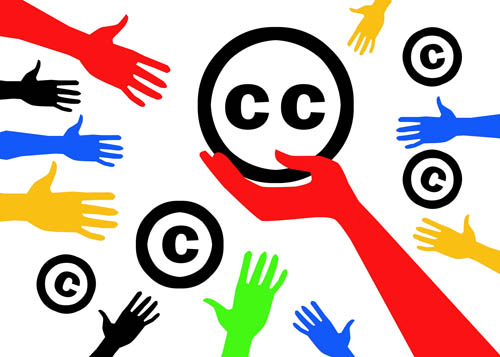
Credit: Sarycheva Olesia.
For the general public as well as individual artists, there are many questions about copyright law, individual rights of ownership, and fair use. Copyright is a legal term with ethical implications. We are looking at copyright through an ethical lens. Discussions with two copyright lawyers highlight the legal and ethical dimensions of copyright law and fair use.
Take Home Points
- When using material from any other source, always give the citation—always!
- When you ask original creators for permission to adapt a pre-existing short story, graphic novel, play, novel, make sure you keep a copy of all email correspondence showing that the creator/owner agreed to let you use the material.
- Always treat other media-makers’ work with respect—if the material is copyrighted, and if you want to use it, and if fair use does not apply, then ethical and respectful practice entails contacting the media-maker, and obtaining a license to use the material. This often means paying a fee.
- Take the time to familiarize yourself with basic copyright law, rules, and regulations.
- If we, as artists, find people using our work and not applying fair use legitimately, then this needs to be confronted. As filmmakers and media-makers, we would not want someone to bend the requirements of fair use as a way of avoiding compensating us as artists for our work.
- We are collaborating most with the people in front of our cameras. What are they getting out of participating in the project and do they fully understand the implications of appearing on camera? Always thoroughly explain how and where the media will be screened as part of asking people to sign release forms.
References
Bernard, S. C., & Rabin, K. (2009). Archival storytelling: A filmmaker’s guide to finding, using, and licensing third-party visuals and music. Burlington, MA: Elsevier Press.
Greenleigh, I. (2014). The social media side door: How to bypass the gatekeepers to gain greater access and influence. New York, NY: McGraw-Hill.
Litman, J. (2001). Digital copyright: Protecting intellectual property on the Internet. Amherst, NY: Prometheus Books.
Postigo, H. (2012). The digital rights movement: The role of technology in subverting digital copyright. Cambridge, MA: MIT Press.
Online
About the licenses. (n.d.). Retrieved from Creative Commons: https://creativecommons.org/licenses/
Aufderheide, P. (2007, August). Fair use put to good use: ‘Documentary filmmakers’ statement’ makes decisive impact. Retrieved from International Documentary Association: www.documentary.org/content/fair-use-put-good-use-documentary-filmmakers-statement-makes-decisive-impact
Center for Media & Social Impact, School of Communication, American University. (2015, February). Dangerous documentaries: Reducing risk when telling truth to power. Retrieved from Center for Media & Social Impact: www.cmsimpact.org/dangerousdocs
Charts and tools. (n.d.). Retrieved from Stanford Copyright & Fair Use Center: http://fairuse.stanford.edu/charts-and-tools/
College Art Association. (2015, February). Code for best practices in fair use for the visual arts. Retrieved from Center for Media & Social Impact: www.cmsimpact.org/fair-use/best-practices/fair-use-visual-arts
Copyright & fair use. (n.d.). Retrieved from Stanford Copyright & Fair Use Center: http://fairuse.stanford.edu/
Documentary filmmakers’ statement of best practices in fair use. (n.d.). Retrieved from Center for Media & Social Impact: www.cmsimpact.org/fair-use/best-practices/documentary-filmmakers-statement-best-practices-fair-use
Johnson, T. (2015, July 29). Filmmaker says unearthed songbook proves ‘Happy Birthday’ is in public domain. Variety. Retrieved from http://variety.com/2015/music/news/filmmaker-says-unearthed-songbook-proves-happy-birthday-is-in-public-domain-1201552544/
Johnson, T. (2015, September 22). ‘Happy Birthday’ not under copyright protection, judge rules. Variety.Retrieved from http://variety.com/2015/biz/news/happy-birthday-song-public-domain-copyright-1201600319/
Mickelsen, J. (n.d.). Answers to common intellectual property questions for the independent documentary filmmaker. Retrieved from Center for Media & Social Impact: www.cmsimpact.org/fair-use/related-materials/documents/answers-common-intellectual-property-questions-independent-docu
Rabin, K. (2008) The ethics of archival use: A roundtable discussion. Retrieved from International Documentary Association: www.documentary.org/content/ethics-archival-use-roundtable-discussion
Stim, R. (2010, October). What is fair use? Retrieved from Stanford Copyright & Fair Use Center: http://fairuse.stanford.edu/overview/fair-use/what-is-fair-use/
The campus guide to copyright: From creative commons to fair use. (n.d.). Retrieved from VideoBlocks Education: http://offers.education.videoblocks.com/campus-guide-creative-commons-fair-use?utm_campaign=Fall%202015%20Copyright%20Guide%20Ad&utm_medium=googl%20e&utm_source=cpc
Film
Black, S. (Director). (2001). Life and debt [Motion Picture]. Tuff Gong Pictures. www.lifeanddebt.org/
Danto, A. (Director). (2011). Reflections on media ethics [Documentary]. San Francisco, California: Forwardintime.com. www.forwardintime.com/store/p161/Reflections_On_Media_Ethics_%282011%29.html
Case Study
Case StudyDiscussion Questions
- What exactly does copyright protect? Why does it exist?
- What is “fair use”? If you want to distribute your film, can you claim “fair use” for if you include a song by someone else? Why or why not?
- What is a Creative Commons license? Why was this kind of licensing developed?
- How do digital media make copyright enforcement more difficult?
- Are existing copyright laws adequate for addressing how we create, view, and share media in the digital age?
Chapter 14
Digital Distribution Ethics
Mobina Hashmi
Summary
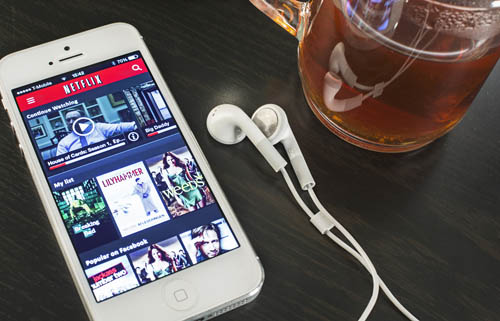
Credit: Twin Design/Shutterstock.com
The ethics of traditional and digital distribution have to be considered at two levels: distribution infrastructures and distribution practices. The debates around net neutrality, media imperialism, and public access illustrate how the regulatory, technical, and economic infrastructures for distribution are shaped by assumptions about the public good, efficiency, and profit that allow certain kinds of media to gain wide circulation while other kinds of media struggle to reach an audience. Through analysis of a range of case studies, this chapter explores how considerations of audience, cultural contexts, and financing shape media producers’ distribution practices. It focuses on issues of access, sharing, and intellectual property rights raised by new forms of digital distribution, but also touches on the role of major distribution companies, alternatives such as public access and independent distribution, and the connections between financing, ownership, marketing, and distribution. The chapter ends with asking media creators to consider three factors: access and audiences, authorship and financing, decisions about sharing and citing on social media.
Take Home Points
- Distribution is so much more than content delivery: it is the creation of a relationship between audiences and media-makers.
- Think about how your distribution choices can support the creation of a more equitable public sphere where all voices can be heard.
- Different distribution infrastructures allow varying degrees of access, privacy, and control for both media-makers and audiences. Your choice of distribution platform carries with it your implicit ethical endorsement of its commercial, social, and political uses.
- Who is your intended audience? Your distribution decisions determine whether the people you want to have access to your work will actually be able to access it.
- A distribution deal with a major company can mean a potentially huge audience. But it can also mean giving up control over how your creation is marketed and promoted. Think through the ethical consequences of this decision.
- As a member of social media publics, think about the impact of your decision to post or share content on the lives of the subjects of that content.
References
The University of California, Santa Barbara’s Media Industries Project has excellent analyses and resources on all aspects of digital distribution.
Appadurai, A. (1996). Modernity at large: Cultural dimensions of globalization. Minneapolis: University of Minnesota Press.
Castells, M. (2000). The information age: Economy, society, and culture (Vol. 1: The rise of the network society) (2nd ed.). Malden, MA: Blackwell.
Christophers, B. (2009). Envisioning media power: On capital and geographies of television. Lanham, MD: Lexington Books.
Cubitt, S. (2005). Distribution and media flows. Cultural Politics, 1(2), 193–214.
Curtin, M. (2007). Playing to the world’s biggest audience: The globalization of Chinese film and television. Berkeley, CA: University of California Press.
Curtin, M., Holt, J., & Sanson, K. (Eds.). (2014). Distribution revolution: Conversations about the digital future of film and television. Berkeley, CA: University of California Press.
Havens, T. (2006). Global television marketplace. British Film Institute.
Mattelart, A. (1994). Mapping world communication: War, progress, culture. Minneapolis: University of Minnesota Press.
Oren, T., & Shahaf, S. (Eds.). (2013). Global television formats: Understanding television across borders. New York: Routledge.
Parks, L. (2005). Cultures in orbit: Satellites and the televisual. Durham, NC: Duke University Press.
Terranova, T. (2000). Free labor: Producing culture for the digital economy. Social text, 18(2), 33–58.
Online
Bateman, D. (2016, January 3). So you want to be a social media star? Some are ‘barely scraping by.’Thestar.com. Retrieved from www.thestar.com/business/2016/01/03/so-you-want-to-be-a-social-media-star-some-are-barely-scraping-by.html
Cadwalladr, C. (2013, November 30). My week as an Amazon insider. The Guardian. Retrieved from www.theguardian.com/technology/2013/dec/01/week-amazon-insider-feature-treatment-employees-work
Collected Authors. (2014, December 13). This tweet called my back. Retrieved from https://modelviewculture.com/pieces/thistweetcalledmyback
Federal Communications Commission (2015, March 12). Report and order on remand, declaratory ruling, and order. FCC 15-24. Retrieved from https://apps.fcc.gov/edocs_public/attachmatch/FCC-15-24A1.pdf
Fox, Kraig G. (1992). Paramount revisited: The resurgence of vertical integration in the motion picture industry. Hofstra Law Review, 21(2). Retrieved from http://scholarlycommons.law.hofstra.edu/hlr/vol21/iss2/6
Gillmore, D. (2014, April 18). As we sweat government surveillance, companies like Google collect our data. The Guardian. Retrieved from www.theguardian.com/commentisfree/2014/apr/18/corporations-google-should-not-sell-customer-data
Grove, E. (2015, July 5). 10 distribution basics. Retrieved from www.raindance.org/10-film-distribution-basics/
Johnson, B. (2009, October 14). Finland makes broadband access a legal right. The Guardian. Retrieved from www.theguardian.com/technology/2009/oct/14/finland-broadband
Katsarova, I. (2014, December). An overview of Europe’s film industry. European Parlimentary Research Service. PE 545.705. Retrieved from www.europarl.europa.eu/RegData/etudes/BRIE/2014/545705/EPRS_BRI%282014%29545705_REV1_EN.pdf
Lessig, L. (2004). Free culture: How big media uses technology and the law to lock down culture and control creativity. New York: Penguin. www.free-culture.cc/
Mendelsen, S. (2013, December 31). In “defense” of the Brad Pitt “12 Years A Slave” posters. Forbes. Retrieved from www.forbes.com/sites/scottmendelson/2013/12/31/in-defense-of-those-brad-pitt-12-years-a-slave-posters/#2715e4857a0b42e47e494bee
Ronson, J. (2015, February 12). How one stupid tweet blew up Justine Sacco’s life. The New York Times Magazine. Retrieved from www.nytimes.com/2015/02/15/magazine/how-one-stupid-tweet-ruined-justine-saccos-life.html?_r=0
Vidal, J. (2013, December 14). Toxic ‘e-waste’ dumped in poor nations, says United Nations. The Guardian. Retrieved from www.theguardian.com/global-development/2013/dec/14/toxic-ewaste-illegal-dumping-developing-countries
Film
Barret, E. (Director). (1999). Stranger with a camera [Documentary]. United States: PBS. www.pbs.org/pov/strangerwithacamera/
Mehta, J. (Producer) & Elayat, Y. (Producer). (2011). 18 days in Egypt [Documentary]. Available at http://beta.18daysinegypt.com/
Pugh, C. (Producer). (2010/2014). Star wars uncut [Motion Picture]. Available at www.starwarsuncut.com/about
Case Study
Case StudyDiscussion Questions
- What are three ways in which certain values are built into the distribution infrastructure itself, independent of how that infrastructure is actually used?
- George Stoney says that “where and when something is seen influences the morality of the material as much as anything else.” Can you think of examples of this? What might this mean in the age of the internet when images and videos posted on sites such as Facebook or YouTube can easily be seen by people other than the creator’s intended audience?
- What are the pros and cons of traditional distribution for filmmakers?
- What are the pros and cons of digital distribution for filmmakers?
- In what ways is “sharing” on social media similar to or different from “distribution” of media content online?